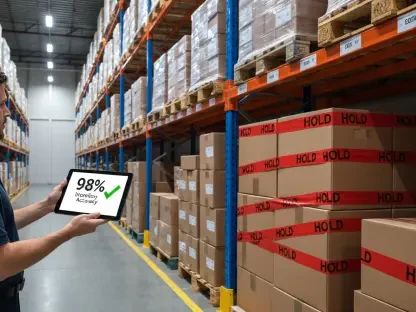In a trade landscape increasingly shaped by steep tariffs on Chinese imports, small- to medium-sized businesses (SMBs) face unprecedented challenges in maintaining profitability while keeping consumer prices in check. One such company, based in Los Angeles, has become a focal point for understanding how these policies ripple through supply chains. Specializing in houseware products like air fryers, grills, and dinnerware, this business is navigating a tariff burden that has climbed to staggering levels, with rates hitting at least 145% earlier this year. Rather than shifting sourcing away from China, the company has chosen to double down on existing partnerships, employing creative strategies to mitigate financial strain. This decision raises broader questions about the feasibility of supply chain diversification and the real impact of trade policies on SMBs in competitive, low-margin industries. The following exploration delves into the reasons behind this stance and the adaptive measures being taken in a turbulent economic environment.
Navigating the Tariff Landscape
Challenges of Supply Chain Diversification
The decision to remain tied to Chinese manufacturing is rooted in a stark reality: no other region currently matches China’s production capacity or quality standards for high-volume orders. The president of the Los Angeles-based houseware company has expressed skepticism about alternatives in countries like Malaysia, Thailand, and Indonesia, where some factories have begun outsourcing operations. Despite these efforts, samples from these regions have consistently failed to meet the rigorous standards required for mass production. This reflects a broader dilemma for many businesses under tariff pressure, as infrastructure and expertise in alternative locations often fall short. The challenge of relocating supply chains is not merely logistical but also tied to maintaining product consistency, a critical factor in retaining consumer trust. For SMBs, the risk of quality compromise during a sourcing shift can outweigh the potential cost savings of avoiding tariffs, making the status quo a safer, if more expensive, choice.
Beyond the immediate hurdles of quality control, the long-term outlook for diversification remains uncertain. Industry experts note that building comparable manufacturing ecosystems in other countries could take years, if not decades, of investment and development. For a company reliant on producing hundreds of thousands of units annually, such a timeline is impractical amidst immediate financial pressures. The reluctance to pivot away from China is compounded by the lack of viable short-term solutions, leaving businesses to grapple with escalating costs while searching for sustainable paths forward. This situation underscores a critical tension in global trade: while political pressures push for reduced reliance on Chinese manufacturing, the practical barriers to achieving this goal remain formidable. The houseware distributor’s experience serves as a case study for countless others caught in the crosshairs of trade policy, highlighting the complex interplay of economics and geopolitics.
Financial Impact on Small Businesses
The financial toll of tariffs on SMBs is profound, often threatening to erase entire profit margins in a single fiscal cycle. For the houseware company in focus, the hundreds of thousands of dollars spent on duties represent a significant drain on resources, with the potential to render an entire year’s efforts unprofitable. Unlike larger corporations with deeper financial reserves, smaller entities lack the cushion to absorb such hits, making each tariff increase a direct threat to survival. The president of the company has warned of a particularly tough period ahead for businesses in this sector, a sentiment echoed by industry voices like those from the National Retail Federation. This precarious position illustrates the disproportionate burden placed on SMBs, which must navigate the same trade challenges as giants but with far fewer tools at their disposal.
Compounding the issue is the ripple effect across the broader economy, as increased costs for one business inevitably impact others down the line. Retailers, already operating on thin margins, face the dilemma of passing on higher prices to consumers or absorbing losses themselves. For the houseware distributor, the fear is not just internal financial collapse but also the cascading consequences for partners and customers. This interconnected strain highlights a critical flaw in tariff policies: while designed to protect domestic interests, they often place undue stress on the very businesses they aim to support. The ongoing struggle of SMBs to balance operational viability with affordability for consumers paints a sobering picture of resilience tested by external forces beyond their control, raising questions about the long-term sustainability of such trade measures.
Adaptive Strategies in a Tough Market
Inventory Management and Cost Absorption
To weather the storm of rising tariffs, the houseware company has adopted a proactive approach to inventory management as a buffer against future uncertainties. By frontloading imports—stockpiling around five months’ worth of goods in January compared to the typical three months—the business aims to shield itself from anticipated duty hikes during the current administration’s term. This strategy, while effective in the short term, requires careful financial planning to avoid overstocking or cash flow issues. Additionally, the company has streamlined its inventory mix, focusing solely on high-turnover stock-keeping units (SKUs) and slashing product variety by half or more. This selective importation reduces exposure to tariff costs on slower-moving items, allowing for a more agile response to market demands while preserving essential revenue streams.
In parallel, a delicate balance is being struck between price adjustments and cost absorption to maintain consumer loyalty. A modest price increase of approximately 10% has been implemented, with the remainder of the tariff burden absorbed internally. In a low-margin industry like small electrics and dinnerware, where price sensitivity runs high, passing on the full cost to buyers is deemed impractical. This approach reflects an acute awareness of market dynamics, as alienating customers with steep hikes could jeopardize long-term viability. Retailers have shown a surprising willingness to accept these adjustments, signaling an industry-wide recognition of tariff-driven cost pressures. However, for an SMB, absorbing even a portion of these expenses remains a significant sacrifice, underscoring the tightrope walk between profitability and affordability in a challenging economic climate.
Industry-Wide Acceptance of Price Hikes
A notable shift in the retail landscape is the growing acceptance of higher prices among both retailers and consumers, driven by the pervasive impact of tariffs. Major retailers have not resisted the houseware company’s price adjustments, indicating a shared understanding that such increases are an inevitable consequence of current trade policies. This trend aligns with actions taken by larger industry players, who are similarly preparing for cost adjustments to offset tariff expenses. The normalization of price hikes across the sector suggests a collective adaptation to a new economic reality, where the burden of trade disputes is distributed along the supply chain. For consumers, this may translate to a gradual recalibration of expectations regarding the cost of everyday houseware products.
Yet, this acceptance does not erase the underlying strain on SMBs, which face a steeper climb to maintain market position amidst these changes. The houseware distributor’s experience highlights a critical disparity: while larger brands can leverage economies of scale to mitigate cost increases, smaller players must navigate the same challenges with limited resources. The broader implication is a potential reshaping of competitive dynamics, where only the most adaptable or well-resourced businesses survive prolonged tariff pressures. This evolving landscape raises important considerations about the future of small businesses in global trade, as their ability to endure such financial headwinds will likely determine the diversity and resilience of the market in the years ahead.
Reflecting on Resilience Amid Trade Pressures
Looking back, the journey of the Los Angeles-based houseware company through a tariff-laden trade environment reveals a story of grit and strategic adaptation. The decision to stick with Chinese manufacturing, despite punishing duties, was grounded in the unmatched production capabilities that no other region could replicate at the time. By frontloading inventory, refining product selections, and carefully calibrating price increases, the business managed to weather immediate financial storms while preserving customer relationships. The industry’s broader acceptance of higher costs also provided a small measure of relief, though the disproportionate burden on SMBs remained a stark reality. Moving forward, the focus must shift to advocating for policies that support smaller enterprises through such economic challenges, alongside investments in alternative sourcing regions to reduce long-term dependency. Exploring innovative cost-sharing models with retailers and enhancing supply chain agility could offer sustainable paths to stability, ensuring that resilience, not just survival, defines the future for businesses caught in global trade crosswinds.









